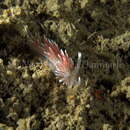en
names in breadcrumbs


Since this species does not have gills, oxygen exchange occurs across the skin surface.
Also, the wide variety of colors seen in nudibranchs is being studied. It is thought that in species like this one, they may be used for camouflage.
Unknown, though some people have been stung when they touched nudibranchs.
Research is currently being conducted to study the adaptation the nudibranch has which allows it to remain unaffected by the nematocyst of their prey. This could benefit humans if researchers understand how they are able to remain unaffected because that could result in treatment for jellyfish stings.
All nudibranchs are carnivorous and feed on sessile or sedentary organisms. This specific species prefers to feed on the hydroid Tubularia indivisia. These hydra are consumed with the aid of a radula, a tongue-like structure with many rows of teeth. The nematocysts, or stinging cells, of the hydra are not digested,and the nudibranch's body transports them to its cerata for protection.
Coryphella lineata is commonly found in shallow zones along the European coasts specifically along British coasts.
Biogeographic Regions: arctic ocean (Native ); atlantic ocean (Native )
Coryphella lineata lives in algal zones of 20-40 m deep along British coasts. They spend most of their time drifting through seaweeds and other aquatic plants on the ocean floor.
Aquatic Biomes: reef ; coastal
Coryphella lineata can grow up to 50mm in length. The body is translucent white. The oral tentacles are long and smooth with wrinkled rhinophores to explore the substrate in front of them. Both the tentacles and rhinophores have a thin white stripe on them which meet on the head. There are also lateral white stripes on the organism. Extending down the back of the organism are thin tubular processes called cerata. The cerata are elongated and can be found in clusters of 5-8 on a pallial ridge. Each cera has a white ring which extends as a longitudinal stripe with the anterior stripe being the thickest one. These cerata are extensions of the digestive gland and liver and are are filled with a digestive gland that varies from yellowish orange to vibrant red. At the tips are undischarged nematocyts which are obtained during the slug's consumption of cnidarians. Since the slug does not have gills,the cerata increase the surface area of the organism, allowing for transpiration via diffusion. Like all nudibranchs, they lack a shell, gills, operculum, and a mantle cavity. (Picton, 2000)
Other Physical Features: ectothermic ; bilateral symmetry
Like all nudibranchs, Coryphella lineata is hermaphroditic. Each individual has male and female gonads and external appendages to exchange sperm by copulation. The genitalia are adapted to eject the sperm, receive allosperm (sperm from their partner) and prevent self fertilization which would lead to inbreeding. Copulation is usually reciprocal, which allows for both individuals to function as male and female, each giving and receiving sperm. Nudibranchs copulate by positioning themselves side by side so that the right sides of their bodies are touching. The copulation period can be brief or last for hours. Later, eggs masses are laid, containing hundreds or thousands of eggs. They are surrounded by mucus sheaths to keep them together and attach them to a substrate. When they hatch, the young live as free-swimming larvae called veligers before settling down and transforming into the adult form.